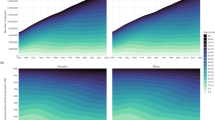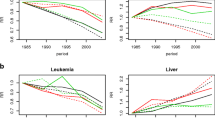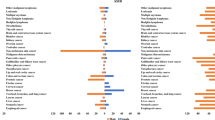Abstract
The Japanese have the longest lifespan worldwide, but this has been mostly due to reductions in the mortality rates from diseases other than malignant neoplasms. Changes in the age-adjusted mortality rates (AMRs) for malignant neoplasms in Japan from 1950 to 2000 are analyzed to elucidate the overall trend. The overall AMRs for all malignant neoplasms in men increased from 1950 to 2000, and decreased slowly in women during the same period. Changes since 1990 have been small in both genders, but show a hopeful trend towards a decrease in the total AMR since 1995. These trends reflect a balance between the decreased AMR from gastric (both male and female) and uterine cancers and increases in many other malignant neoplasms. However, in the period 1990–2000, the decrease in the AMR from gastric and uterine cancers has shown a trend towards leveling off. Therefore, improving the trend towards reductions in cancer incidence and mortality in the 21st century and beyond will depend on achieving changes in other cancer sites, which can only be realized through the twofold approach of preventative medicine and research as well as improvements in the levels of diagnosis and therapy. Much more emphasis must therefore be placed on primary prevention, in particular on anti-smoking campaigns, as well as stepping-up research into the etiology of, and novel treatments for other malignant neoplasms, especially colorectal and breast cancers.
Similar content being viewed by others
References
Bailar III JC, Smith EM. Progress against cancer? N Engl J Med 1986; 314: 1226–1232.
Bailar JC III, Gornik HL. Cancer undefeated. N Engl J Med 1997; 336: 1569–1574.
Lambert T, Guillioux A, Oshima A, et al. Incidence and mortality form stomach cancer in Japan, Slovenia and the USA. Int J Cancer 2002; 97: 811–818.
Kurumatani N, Kirita T, Zheng Y, Sugimura M, Yonemasu K. Time trends in the mortality rates for tobacco-and alcohol-related cancers within the oral cavity and pharynx in Japan, 1950–1994. J Epidemiol 1999; 9: 46–52.
Tamakoshi K, Kondo T, Yatsuya H, Hori Y, Kikkawa F, Toyoshima H. Trends in mortality (1950–1997) and incidence (1975–1993) of malignant ovarian neoplasm among Japanese women: Analyses by age, time, and birth cohort. Gynecol Oncol 2001; 83: 64–71.
Statistics and Information Department, Minister's Secretariat, Ministry of Health and Welfare. Vital Statistics of Japan. 1950–1995. Tokyo: Yamato Sogo Printing, 1952–1997 (In Japanese).
Bureau of Statistics, Office of the Prime Minister. Bureau, Ministry of Finance. Population of Japan, 1950–2000. Tokyo: Yamato Sogo Printing, 1953–2002.
Osaka Cancer Registry. Survival of cancer patients in Osaka 1975–1989. Osaka: Osaka Foundation for Prevention of Cancer and Circulatory Diseases, 1998 (in Japanese).
Parkin DM, et al. (eds) Cancer incidence in five continents, vol. VI, Lyon: IARC Scientific Publications No. 120, International Agency for Research on Cancer, 1992.
The Osaka Prefectural Department of Public Health, Osaka Medical Association, Osaka Medical Center for Cancer and Cardiovascular Diseases. Annual Report of Osaka Cancer Registry No. 61-Cancer incidence and medical care in Osaka in 1998 and the survival in 1994. Osaka: Osaka Prefectural Department of Public Health, 2001 (in Japanese).
Hirayama T. The epidemiology of cancer of the stomach. Itocho 1968; 3: 787–795 (in Japanese).
Kawai K, Takada H, Takekoshi T, et al. Double contrast radiograph on routine examination of the stomach. Am J Gastroenterol 1970; 53: 147–153.
Takemori K, Mikami S, Nihira S, Sasaki N. Relationship of urinary sodium and potassium and of urinary sodium/creatinine, potassium/creatinine and sodium/potassium ratios to stomach cancer and cerebrovascular disease moralities in Japanese women. Tohoku J Exp Med 1993; 171: 185–194.
Hirohata T, Kono S. Diet/nutrition and stomach cancer in Japan. Int J Cancer 1997; Suppl 10: 34–36.
Asaka M, Sugiyama T, Nobuta A, Kato M, Takeda H, Graham DY. Atrophic gastritis and intestinal metaplasia in Japan: Results of a large multicenter study. Helicobacter 2001; 6: 294–299.
Asaka M, Kimura T, Kudo M, et al. Relationship of Helicobacter pylori to serum pepsinogens in an asymptomatic Japanese population. Gastroenterology. 1992; 102: 760–766.
Section of Nutrition, Bureau of Public Health, Ministry of Health and Welfare. National Nutrition Survey, 1986–1999. Tokyo: Daiichi Publishing Co., 1988–2001 (in Japanese).
Japan Tobacco Co. Ltd. Japan Tobacco's Annual Survey in 1960 to 2001, 1961–2002.
Talamini R, Bosetti C, La Vecchia C, et al. Combined effect of tobacco and alcohol on laryngeal cancer risk: A case-control study. Cancer Causes Control 2002; 13: 957–964.
Bonnin-Scaon S, Lafon P, Chasseigne G, Mullet E, Sorum PC. Learning the relationship between smoking, drinking alcohol and the risk of esophageal cancer. Health Educ Res 2002; 17: 415–424.
Pitard A, Brennan P, Clavel J, et al. Cigar, pipe, and cigarette smoking and bladder cancer risk in European men. Cancer Causes Control 2001; 12: 551–556.
Ministry of Health and Welfare. Annual Report on Health and Welfare in 1995. Tokyo: Health and Welfare Statistics Association, 1997, 92 p (in Japanese).
Fuchs CS, Giovannucci EL, Colditz GA, et al. Dietary fiber and the risk of colorectal cancer and adenoma in women. N Engl J Med 1999; 340: 169–176.
Schatzkin A, Lanza E, Corle D, et al. Lack of effect of a low-fat, high-fiber diet on the recurrence of colorectal adenomas. Polyp Prevention Trial Study Group. N Engl J Med 2000; 342: 1149–1155.
Alberts DS, Martinez ME, Roe DJ, et al. Lack of effect of a high-fiber cereal supplement on the recurrence of colorectal adenomas. Phoenix Colon Cancer Prevention Physicians' Network. N Engl J Med 2000; 342: 1156–1162.
Michels KB, Giovannucci E, Joshipura KJ, et al. Prospective study of fruit and vegetable consumption and incidence of colon and rectal cancers. J Natl Cancer Inst 2000; 92: 1740–1752.
Lubin F, Ruder AM, Way Y, Modan B. Overweight and changes in weight throughout adult life in breast cancer etiology: A case-control study. Am J Epidemiol 1985; 122: 579–588.
La Guardia M, Giammanco M. Breast cancer and obesity. Panminerva Med 2001; 43: 123–133.
Singletary SE. Rating the risk factors for breast cancer. Ann Surg 2003; 237: 474–482.
Author information
Authors and Affiliations
Corresponding author
Rights and permissions
About this article
Cite this article
Nakaji, S., Liu, Q., Yamamoto, T. et al. Firm measures are required to effect any significant decrease in the Japanese age-adjusted mortality rate from malignant neoplasms for the 21st century. Eur J Epidemiol 19, 123–128 (2004). https://doi.org/10.1023/B:EJEP.0000017665.58070.19
Issue Date:
DOI: https://doi.org/10.1023/B:EJEP.0000017665.58070.19




